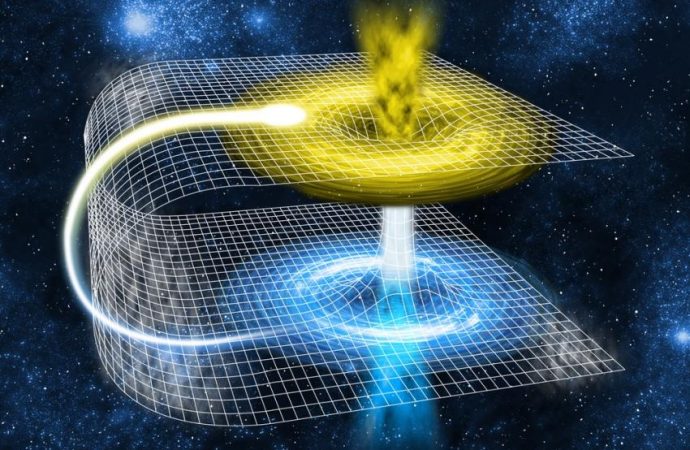Single particles of light (photons) to simulate quantum particles travelling through time were just used by scientists from the University of Queensland, Australia. They showed that one photon can pass through a wormhole and then interact with its older self.

The study of closed timelike curves (CTC’s) provides valuable insight into particles that can loop back on themselves, breaking free of linear time.
“One aspect of general relativity that has long intrigued physicists is the relative ease with which one can find solutions to Einstein’s field equations that contain closed timelike curves (CTCs)—causal loops in space–time that return to the same point in space and time.”
The Science
Closed timelike curves are a necessary concept to understand this experiment.
CTCs are used to simulate powerful gravitational fields, like the ones produced by a spinning black hole, that could theoretically (based on Einstein’s theory of general relativity), warp the fabric of existence so that space-time bends back on itself. This creates a CTC, almost like a pathway to travel back through time.
The source of time travel speculation lies in the fact that our best physical theories seem to contain no prohibitions on traveling backward through time. The feat should be possible based on Einstein’s theory of general relativity, which describes gravity as the warping of spacetime by energy and matter. An extremely powerful gravitational field, such as that produced by a spinning black hole, could in principle profoundly warp the fabric of existence so that spacetime bends back on itself. This would create a “closed timelike curve,” or CTC, a loop that could be traversed to travel back in time. (source)
Experimenting With CTC’s
Single particles of light (photons) to simulate quantum particles travelling through time were just used by scientists from the University of Queensland, Australia. They showed that one photon can pass through a wormhole and then interact with its older self. Their findings were published in Nature Communications.
Much of their simulation revolved around investigating the “grandfather paradox,” a hypothetical scenario in which someone uses a CTC to travel back through time to murder her own grandfather, thus preventing her own later birth.
The Grandfather Paradox in Quantum Physics
Instead of a human being traversing a CTC to kill her ancestor, imagine that a fundamental particle goes back in time to flip a switch on the particle-generating machine that created it. If the particle flips the switch, the machine emits a particle—the particle—back into the CTC; if the switch isn’t flipped, the machine emits nothing.

































68 Comments
Perr
July 7, 2016, 3:31 amThis is PURE speculation, a microcosm of physics in academia. WE DO NOT HAVE TECHNOLOGY THAT CAN CREATE WORMHOLES, are you kidding me??
REPLYroninmd@Perr
July 7, 2016, 8:10 pmDidn’t davinici speculate the helicopter?
REPLYJohn@roninmd
July 8, 2016, 12:40 amI’m just here to kill my grandfather for voting for Trump.
REPLYSid Goldberg@Perr
July 8, 2016, 9:32 amYou are correct, Perr. The article clearly states that the simulations were based upon speculation. Not everyone reads the article fully thus some knee-jerk reactions.
REPLYMike@Perr
July 9, 2016, 8:50 amNot required, one must only devise an experiment in which the end result affects the commencing conditions. Theoretically a double slit setup where a particle could interfere with itself before the entire wavelength passed an arbitrary point would satisfy that critera without needing to actually send the particle back in time. However, if anyone were smart enough to devise such an experiment; They would be writing this article instead of replying to it… Paradox? Checkmate…
REPLYVanessa@Perr
July 9, 2016, 12:10 pmWell, according to http://www.scientificamerican.com/article/according-to-current-phys/
REPLYWe don’t need technology to create a worm hole, there are already microscopic worm holes in time and space.
DM@Vanessa
July 9, 2016, 1:20 pmWell that’s just silly. If there are microscopic wormholes, where are the microscopic worms that made them?
#boom # argumentover #iamsosmrt
REPLYRobyn Smith@DM
July 11, 2016, 1:54 pmI think they jumped out of my brain and are now mostly eating yours
REPLYShawn
July 8, 2016, 12:45 amI would think that the Grandfather Paradox would simply be impossible because even if you send yourself back in time, you already exist in the future and cannot change that. You actually send basically a clone of yourself back in time, or you from the time that you send yourself back. But you future self remains reguardless of those actions in the past. Kind of like the new Star Trek movies, you simply create an alternate timeline without changing the current line.
REPLYDavid McDonald@Shawn
July 8, 2016, 5:54 pmI’m certainly not a physicists but love anything related to Time Travel. As a person who worked in & around Broadcast Transmitters a lot in my earlier career I always wished there was a way to send an audio signal back into time & receive it before I sent it. But I guess I never sent one or maybe I just had bad reception. Great article & experiment, thanks!
REPLYWarrec@Shawn
July 9, 2016, 3:00 pmA lot of people see really concerned about paradoxical reactions. However, more recent research suggests that in a universe where travelling backwards in time is a possibility that a paradox is already not an issue in major history cases because you can only travel back to the point of origin of the time travel device or to a person’s initial encounter of one.
REPLYT. Logan Russell@Shawn
July 11, 2016, 9:52 pmI think you may be close Shawn but what if the alternate timelines already exist? In other words, what if it’s not a matter of creating an alternate timeline rather it is a matter of "leaping" from the current timeline to the alternate?
REPLYsteve show@Shawn
July 14, 2016, 4:38 amSurely if time travel will ever exist in the future then we would already know about it now
REPLYJim Oneill
July 8, 2016, 7:03 amAre the chief investigators named Omega and Rassilon?
REPLYAlliesha@Jim Oneill
July 9, 2016, 1:13 pmI enjoy this Doctor Who comment and also your profile avatar.
REPLYPeksu-66@Alliesha
July 15, 2016, 2:58 pmProbably it still was the Other guy.
REPLYBill
July 8, 2016, 8:54 amIDIOTS.
The article title should have read: "Physicist Simulate Sending Particles of Light Into the Past, Strengthening the Case that Time Travel Is Possible."
At least then I might think the author of his article understood the research being reviewed.
REPLYSid Goldberg@Bill
July 8, 2016, 9:28 amThe article clearly states it is a simulation. Many people do not read more than the title, which is unfortunate.
REPLYBryan@Sid Goldberg
July 8, 2016, 3:02 pmSo is this a science news site or click bait? The title is clearly sensationalistic implying something about the article and what transpired in the experiements that is simply false. Requiring the reader to read the article to realise the title drew them in via false pretenses is click bait garbage. Thanks for reporting on the information but I came here expecting an amazing scientific break through, not a letdown. A simulation isnt proof and scientists didnt actually do anything except crunch some mathematical equations to support a hypothesis.
REPLYSid Goldberg@Bryan
July 8, 2016, 3:35 pmPoint well taken Bryan. NO ONE likes “click bait” and the negative reputation that creates. We have have changed the title to:
“Physicist Simulate Sending Particles of Light Into the Past, Strengthening the Case that Time Travel Is Possible”
Thanks for taking the time to bring this to our attention!
REPLYJames W. Hikins@Sid Goldberg
July 9, 2016, 4:34 pmI must be caught in a bird hole (that just ate a worm hole, because, of course, the bird got up early and noticed that the suggested title is not in proper grammatical form). It should read "Physicist simulates…."
REPLYOn the other hand, if I could go back in time, I’d probably delete this post before I push "POST COMMENT". However, having gone this far, I guess I could add the caution that simulating something by, for example, computer modeling, does not necessarily translate into the real world. As others have noted, if I am a meteorologist and run a program that predicts rain, I do not get wet. Anyway, that’s all I have to say about that…
Robyn Smith@Sid Goldberg
July 11, 2016, 1:56 pmSadly most people prefer pictures to words…..
REPLYSid Goldberg@Bill
July 8, 2016, 3:36 pmYour point is well taken as is the new title suggestion. Thanks for writing in to say so. It has been changed!
REPLYfhhfh@Bill
July 8, 2016, 3:55 pmThat is what the title says… Did they change it?
REPLYFrostByte@fhhfh
July 8, 2016, 6:25 pmThey went back in time and changed the title before the article was written 🙂
REPLYHarold @FrostByte
July 8, 2016, 9:49 pmhahahahahahaha.
But even that was probably simulated.
hahahahahahaha!
REPLYfhhfh
July 8, 2016, 3:57 pmOh I just refreshed the page and you already confirmed that, wow! Unfortunately, external links still show the old one but whatever.
REPLYSid Goldberg@fhhfh
July 8, 2016, 4:06 pmYes after it was brought to my attention I changed the title to better reflect the essence of the article. Unfortunately, it does not refresh on what has already gone out. I appreciate those EMN followers who have pointed this out. We are not here to sensationalize but to be a credible source of information. Again, thank you all.
REPLYstephen@Sid Goldberg
July 8, 2016, 8:05 pmAll times are now, there are no past or furure
REPLYNick@stephen
July 9, 2016, 4:30 pmAs I understand it there’s a direction in time. Has something to do with a small difference in how matter decays all arrows point in one direction
REPLYJaqulin Wallace@Nick
July 9, 2016, 5:46 pmThere is no "direction" in time. Time is a scalar. It has no direction but it has a magnitude. Time could not possibly have arrows.
REPLY